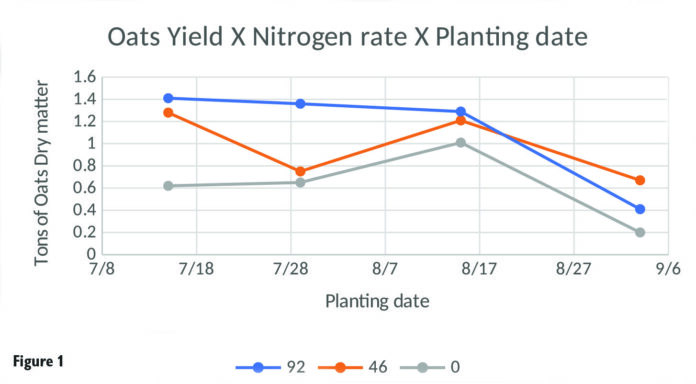By Allen Gahler
With challenges all around Ohio — from drought to excessive rain, and then back to dry areas in some places but extreme rain and storms through July in other areas — forage production has certainly seen its challenges this year.
If supplemental forages may be needed for livestock operations, it might be another good year to consider summer-planted oats to fill that need.
Oats traditionally is planted as the first crop in early April as a grain crop or an early season forage. One of the beauties of oats is its versatility in planting date. Oats can also be planted in the summer as a late summer or early fall forage for harvest or grazing.
Summer oats has a wide planting window but performs much better with an application of nitrogen and may benefit from a fungicide application to improve quality.
Study
During the summer of 2019, we conducted a study to examine the planting of oats from July 15 through early September to examine tonnage and forage quality. Through this trial, we examined planting date, yield, forage quality and an application of foliar fungicide to control oats crown rust.
Usually, the best scenario for growing oats for forage is to plant them into wheat stubble, which is normally available by mid-July at the latest. However, based on prior research, the typical recommendation is to plant oats between Aug. 1 and Aug. 10 to maximize tonnage and quality, since the shorter day length triggers oats to grow more leaf rather than try to produce seed. If planted too late in the year, there is not enough time for growth.
The oats in this study were harvested between 60 and 75 days after planting, mostly with full head emergence. Figure 1 shows how yield changed based on planting date and nitrogen rate. Similar to previous studies, applying 46 pounds of nitrogen significantly increased yield on all planting dates but applying 92 pounds only increased yield during the late July planting. The July planting date did not receive rain for eight days then received about 1.5 inches possibly leading to a loss of nitrogen.
Adding this study to others, the recommended nitrogen rate for summer oat forage is to apply 50 pounds of nitrogen at planting. When planted in early September, yields fall to and average of a half-ton per acre making it less economical to mechanically harvest as stored forage and more economical to graze.
Not only does nitrogen rate affect yield but also the feed value of the oats. In 2019, the oats were severely infected with crown rust. Fungicide was sprayed on the plots at approximately 30 days post-planting. The fungicide application significantly reduced the presence of rust. Without a fungicide application over 50% of the leaf was covered by rust, while the fungicide application prevented the severe outbreak and decreased the rust content to less than 1% coverage on average.


Figure 2 and 3 show the crude protein and total digestible nutrients over the four planting dates across three rates of nitrogen with and without fungicide. Fungicide application had no effect on yield but did affect forage quality. The application of nitrogen increased forage quality but only the mid-August planting saw a difference between 46 and 92 pounds of nitrogen for both CP and TDN. The application of fungicide improved oats’ digestibility, increasing protein by 1-2% and energy by 5 points.
Energy also saw a consistent increase overall treatments based on planting date. Crude protein averaged around 14% when nitrogen was applied but only 10% without nitrogen. TDN had an average of 50 with a nitrogen application and 40 without a nitrogen application.
Recommendations
Based on previous trials, we recommend seeding oats at 2-3 bushels per acre and applying 50 pounds of nitrogen at planting. With most seed oats or triple cleaned feed oats commonly used for fall forage, test weight is normally much higher than the standard 32 pounds, so a more accurate assessment for planting rate may be to seed 80-100 pounds per acre, regardless of the source.
The oats should be planted into moisture up to 1.5 inches deep if needed. No-till planting is the ideal seeding method but shallow conventional tillage may be required to incorporate nitrogen, assist with weed control and improve seed-to-soil contact if drills are not closing the seed slot.
Just keep in mind that if mechanical harvest is the intention, loose soils from conventional tillage may contribute to significant soil in the harvested crop, leading to higher ash content in the feed. If weeds are present, a chemical application of Glyphosate plus 2,4- D can be used to clean fields up before planting or before oats has emerged.
When harvested as a stored forage, oats often need to be harvested as silage or baleage. If the weather allows for dry harvest, the oats usually need tedded multiple times, and in late September or October, six or more days of drying may be required.
Oats make an excellent double crop after wheat. When planted between mid-July and mid-August and fertilized with at least 46 pounds of nitrogen, average yields are in the range of 1-1.5 tons dry matter, and with ideal conditions, three or more tons is very possible.
Oats make an excellent forage for sheep, goats, beef cows, feeder calves, dairy heifers, and when made early, even milking cows. Planting after wheat harvest provides forage and increases farm profitability, with return on investment rivaling and often surpassing the potential for double-crop soybeans.
(Allen Gahler is an OSU Extension ag and natural resources extension educator in Sandusky County.)













